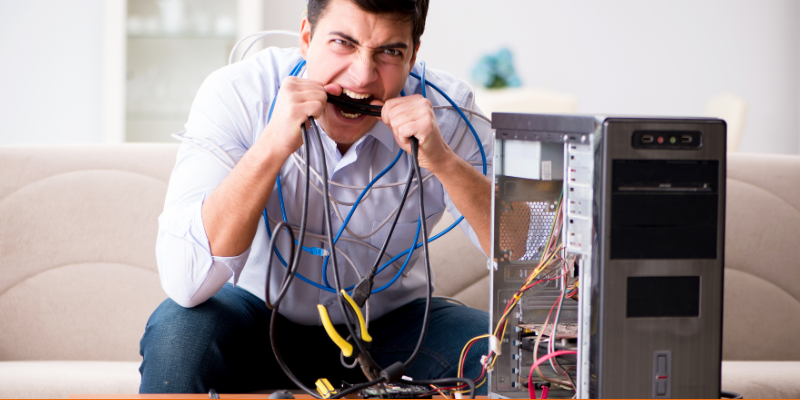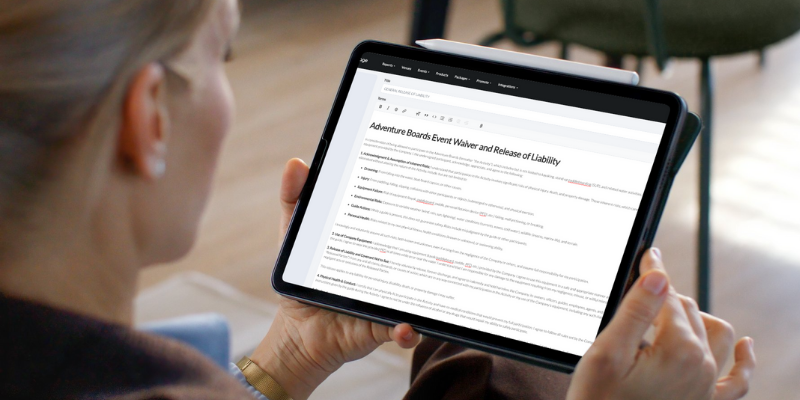That sinking feeling when the projector bulb burns out right before the keynote speaker takes the stage. The caterer arrives late with the food, or a sudden downpour soaks your outdoor festival.
It’s the Murphy's Law of Events: Anything that can go wrong at your event, will go wrong at your event, and at the worst possible moment. Even with the best planning, unexpected problems will inevitably arise.
Technical difficulties are one of the most common problems event planners face, but they don’t have to ruin your big day. With a little advance preparations, and flexibility in the moment, you can overcome even the biggest of tech glitches during your event. Here are the top 5 technical issues for events and how to solve them.
1. Internet Connectivity Issues
Slow or unreliable Wi-Fi, insufficient bandwidth, and complete internet outages. These problems can disrupt everything from registration and ticketing to presentations and live streaming.
Wi-Fi outages at events can be disruptive, but here's a breakdown of what you can do:
Immediate Actions
-
Assess the Scope: Is it just a few people, a specific area, or the entire venue? This helps pinpoint the problem. Talk to attendees and staff to get a sense of how widespread the issue is.
-
Modem/Router: Check your modem and router lights. Are they indicating a problem? Sometimes a simple restart (unplug, wait 30 seconds, plug back in) can fix things.
-
Cables: Ensure all cables connected to the modem, router, and any network switches are securely plugged in.
-
Breaker: Check if a circuit breaker has tripped, especially if the outage is localized.
-
Contact Your Provider/Venue: If you're using a dedicated event Wi-Fi provider, contact them immediately. If the venue is providing the Wi-Fi, inform their IT or event staff. They may be aware of an outage or have solutions in progress. Get an estimated time for restoration if possible.
Contingency Plans
-
Personal Hotspot: If the outage is widespread and you have a mobile phone with a decent data plan, consider using it as a personal hotspot (tethering). This can provide limited internet access for essential tasks. Be mindful of data limits and potential costs.
-
Other Networks: Are there any nearby businesses or public spaces with Wi-Fi you could temporarily utilize for critical tasks?
-
Prioritize Critical Needs: Determine which activities are most dependent on the internet. Can anything be shifted to later or done offline?
-
Paper-Based Registration/Check-in: If you're using online registration, have a backup paper-based system ready.
-
Offline Presentations: If presentations are affected, have presenters prepared to deliver their talks without internet access. This might mean having presentations saved locally on laptops.
-
Document the Issue: Keep a record of the outage, including when it started, when it was resolved (if it is), and any steps you took. This information can be helpful for post-event analysis and future planning.
Communication Tips
-
Inform Attendees: Keep attendees updated about the situation. Let them know you're working on it and provide any alternative arrangements. A simple announcement or sign can prevent confusion.
-
Staff Communication: Ensure your event staff are aware of the outage and any contingency plans.
Prevention for Future Events
-
Redundancy: Consider having a backup internet connection from a different provider.
-
Load Testing: Before the event, test the Wi-Fi network with a simulated load similar to your expected attendance. This can help identify potential bottlenecks.
-
Dedicated Tech Support: If your event is large or technically complex, consider hiring dedicated IT support for the event.
-
Clear Communication Plan: Have a documented plan for how you will communicate with attendees and staff in case of a technical outage.
By taking these steps, you can minimize the impact of a Wi-Fi outage and keep your event running as smoothly as possible.

2. Audio-Visual Equipment Malfunctions
Problems with microphones, speakers, projectors, screens, and other AV equipment. These issues can lead to poor sound quality, blurry images, or complete AV failures, which can disrupt presentations and performances.
Experiencing an AV equipment failure during your event can be stressful, but here's a breakdown of how to handle it:
Immediate Actions
-
Identify the Problem: What's not working? Is it the microphone, speakers, projector, screen, or something else?
-
When did it start? Was it sudden or gradual?
-
Is it affecting everyone or just a few people? This helps narrow down the cause.
-
-
Check the Power: Is the equipment plugged in and turned on? Check power cords, outlets, and circuit breakers.
-
Check Connections: Are all cables securely connected at both ends? Try unplugging and replugging them.
-
Microphone Troubleshooting: Check if it's muted or if the batteries are low.
-
Speakers: Adjust the volume and check for any error messages.
-
Projector: Ensure it's properly connected and the lens cap is off.
-
Screen: Check if it's positioned correctly and the controls are working.
-
Contact On-site AV Technician: If you have one, notify them immediately.
-
Alert Venue Staff: If the venue is providing AV support, inform their staff.
-
Contact Rental Company:
If you rented the equipment, contact them for assistance.
Contingency Plans
-
Alternate Microphone: Can someone project their voice without a microphone? Is there a backup microphone available?
-
Portable Speakers: Can you use a portable speaker or move the event to a smaller room with better acoustics?
-
Backup Projector: Can you use a flip chart, whiteboard, or share printed copies of the presentation?
-
Makeshift Screen: Can you use a blank wall or a large sheet as a makeshift screen?
Communication Tips
-
Acknowledge the issue: Let attendees know you're aware of the problem and working on it.
-
Provide updates: Keep them informed about the progress and any alternative arrangements.
-
Maintain a positive attitude: Your demeanor can help ease any frustration.
-
Shift the schedule: Can you rearrange the agenda to allow time for troubleshooting?
-
Shorten presentations: Can speakers focus on key points and skip less essential content?
-
Incorporate interactive activities: Can you engage the audience with discussions or group activities?
-
Document the Issue: Record the time, nature of the problem, and any steps taken.
-
Gather feedback: Ask attendees for their input on how to improve the situation.
-
Use this information: To prevent similar issues in future events.
Prevention for Future Events
-
Test all equipment: Before the event, test every piece of AV equipment to ensure it's working properly.
-
Conduct a rehearsal: Do a full run-through with presenters to identify any potential issues.
-
Backup Equipment: Keep backup microphones, cables, and other essential items on hand.
-
Consider a backup projector: If possible, have a spare projector available in case of failure.
-
On-site technician: For large or complex events, hire a dedicated AV technician.
-
Venue support: Ensure the venue has adequate technical staff to handle any issues.
-
Document procedures: Have a plan for how to handle AV failures and communicate with attendees.
-
Train staff: Ensure your event staff are familiar with the plan and know how to assist.
By taking these steps, you can minimize the impact of AV equipment failures and ensure your event runs smoothly.

3. Power Outages
Power outages can cause a variety of problems, including the loss of lighting, sound, and internet connectivity. They can also damage equipment and cause delays or cancellations.
Losing power at your event can be a major setback, but here's how to manage it:
Immediate Actions
-
Emergency Lighting: If available, activate emergency lighting immediately. This will help prevent accidents and keep the venue safe.
-
Evacuation: If the power outage is severe or prolonged, you may need to evacuate the venue. Follow established emergency procedures and guide attendees to safety.
-
Assess the Situation: Try to determine the cause of the power outage. Is it a local issue, a problem with the venue's electrical system, or a wider blackout?
-
Duration: How long is the outage expected to last? Contact the power company or venue staff for an estimated restoration time.
Communication Tips
-
Inform Attendees: Keep attendees updated about the situation and any changes to the event schedule. Use announcements, signs, or social media to communicate effectively.
-
Staff Communication: Ensure your event staff are aware of the outage and any contingency plans.
-
Contact Information: Have a list of contact numbers for the power company, venue staff, and emergency services.
- Communication Strategy: Develop a plan for how you will communicate with attendees and staff during a power outage.
Contingency Plans
-
Generators: If you have access to generators, use them to power essential equipment like lighting, sound systems, and emergency exits.
-
Battery-Powered Equipment: Utilize battery-powered devices like microphones, speakers, and lighting to keep the event going.
-
Adjust the Schedule: Can you shift the schedule to accommodate the power outage? Can any activities be moved to a time when power is restored?
-
Modify Presentations: Can speakers deliver their presentations without visual aids? Can they focus on key points and engage the audience in discussions?
-
Alternative Activities: Can you incorporate activities that don't require power, such as networking sessions, group discussions, or entertainment that doesn't rely on electricity?
-
Stay Calm: Your demeanor can help ease any frustration or anxiety among attendees.
-
Be Flexible: Be prepared to adapt to the situation and make changes as needed.
-
Offer Support:
Provide assistance to attendees and address any concerns they may have.
Prevention for Future Events
-
Emergency Kit: Prepare an emergency kit with flashlights, batteries, first aid supplies, and other essential items.
-
Backup Power: Consider having backup generators or battery-powered equipment available in case of a power outage.
-
Venue Electrical System: Evaluate the venue's electrical system and identify any potential weaknesses.
- Emergency Procedures: Familiarize yourself with the venue's emergency procedures and evacuation plans.
By taking these steps, you can minimize the impact of a power outage and ensure the safety and well-being of your attendees.
4. Software and Hardware Glitches
This can include problems with computers, laptops, tablets, printers, and other devices. These issues can cause delays, errors, and frustration for attendees and event staff.
Software and hardware glitches are almost inevitable at some point. Here's a breakdown of how to handle them during your event:
Immediate Actions
-
Identify the Problem: What's not working? Be specific. Is it a particular program, a peripheral device (mouse, keyboard, printer), or the whole system?
-
When did it start? Was it after a specific action, or did it happen randomly?
-
Is it affecting everyone or just one person/device? This helps isolate the issue.
-
-
Restart: The classic first step. Often, a simple restart can resolve temporary software conflicts.
-
Connections: If it's a peripheral, check all cables are securely plugged in at both ends.
-
Power: Ensure devices are properly powered on and plugged in. Check batteries if applicable.
-
Error Messages: Note down any error messages you see. They can provide clues for troubleshooting.
-
Check Other Devices: If possible, try the same action on a different device. If it works there, the problem is likely with the original device.
-
Check Other Software: If it's a software issue, try a different program. If the problem persists, it might be a system-wide issue.
-
Check for Updates: If the software is known to have bugs, check for updates or patches.
-
Consult Documentation: Look at the software's help files or online documentation for troubleshooting tips.
-
Search Online: Search for the specific error message or problem you're experiencing. Others may have encountered the same issue.
-
Try a Different Port/Cable: If it's a peripheral, try a different USB port or cable.
-
Check Device Drivers: Ensure the device drivers are up to date.
-
Test on Another System: If possible, test the hardware on another computer to see if the problem is with the device or the original system.
Contingency Plans
-
Alternative Devices/Software: Do you have backup devices or software that can be used?
-
Manual Processes: Can the task be done manually? For example, if a printer fails, can you write information on a flip chart?
-
Prioritize Tasks: Which tasks are most critical? Focus on those that can be done without the affected equipment.
Communication Tips
-
Document procedures: Have a documented plan for how to handle software and hardware glitches.
-
Train staff: Ensure your event staff are familiar with the plan and know how to assist.
-
Inform Attendees: If the glitch is affecting attendees (e.g., a presentation screen goes down), let them know you're working on it.
-
Staff Communication: Keep your event staff informed and assign tasks as needed.
Prevention for Future Events
-
Test all software and hardware: Before the event, test everything thoroughly to identify potential issues.
-
Rehearse: Do a full run-through of your event to catch any glitches.
-
Have spares: Keep backup devices, cables, and software licenses on hand.
-
Image Backups: Create system image backups of your computers so you can quickly restore them if necessary.
-
On-site technician: For large or complex events, consider having a dedicated IT person available to assist with technical issues.
-
Venue support: Check what level of technical support the venue provides.
By taking these steps, you can minimize the impact of any software glitches and technical failures that may happen at your next event.

5. Cybersecurity Threats
Events can be vulnerable to cybersecurity threats, such as hacking, malware, and data breaches. These threats can compromise sensitive information, disrupt operations, and damage the reputation of the event and its organizers.
A cybersecurity incident at your event can be a serious issue. Here's a breakdown of how to handle it:
Immediate Actions
-
Isolate Affected Systems: Disconnect any computers or devices that may be compromised from the network immediately. This helps prevent the spread of malware or further data breaches.
-
Stop Affected Services: If a specific service or application is under attack, shut it down to limit the damage.
-
Identify the Scope: What systems or data have been affected? Is it a localized issue or widespread?
-
Type of Attack: What kind of attack is it? Is it ransomware, a denial-of-service attack, a data breach, or something else? This will influence your response.
-
Extent of Damage: How much data has been compromised or lost? Are critical systems down?
-
Contact Law Enforcement: If the attack involves sensitive data or is a serious crime, contact law enforcement immediately.
-
Seek Legal Counsel: Consult with a lawyer specializing in cybersecurity and data breaches. There may be legal obligations for reporting the incident.
Communication Tips
-
Internal Communication: Inform your event staff and relevant stakeholders about the situation.
-
External Communication (If Necessary): Depending on the nature of the breach and legal requirements, you may need to inform attendees, sponsors, or the public. Be transparent but avoid giving out too much information that could compromise the investigation.
Incident Response
-
Preserve Evidence: Do not tamper with affected systems. This is crucial for forensic analysis.
-
Document Everything: Keep detailed logs of what happened, when it happened, and what steps you took.
-
Investigate the Attack: Hire experienced cybersecurity professionals to investigate the attack and determine the root cause.
-
Forensic Analysis: They will perform forensic analysis to understand how the attackers gained access and what they did.
-
Remove Malware: If malware is involved, remove it completely from all affected systems.
-
Patch Vulnerabilities: Identify and patch any security vulnerabilities that were exploited by the attackers.
-
Restore from Backups: If data has been lost or corrupted, restore it from backups. Ensure your backups are clean and not also compromised.
-
Post-Incident Analysis: After the incident, conduct a thorough review to understand what happened and how to prevent similar attacks in the future.
-
Strengthen Security Measures: Implement stronger security measures, such as firewalls, intrusion detection systems, and employee training.
Prevention for Future Events
-
Firewall and Intrusion Detection: Implement a strong firewall and intrusion detection system to protect your network.
-
Antivirus and Anti-malware: Use up-to-date antivirus and anti-malware software on all devices.
-
Strong Passwords and Multi-Factor Authentication: Enforce strong passwords and multi-factor authentication for all accounts.
-
Vulnerability Scanning: Regularly scan your systems for vulnerabilities.
-
Penetration Testing: Conduct penetration testing to simulate attacks and identify weaknesses in your security.
-
Security Awareness Training: Train your event staff on cybersecurity best practices, such as recognizing phishing emails and avoiding suspicious websites.
-
Develop a Plan: Create a detailed incident response plan that outlines how you will handle a cybersecurity incident.
-
Regularly Test the Plan: Practice your incident response plan to ensure everyone knows what to do in case of an attack.
-
Regular Backups: Back up your data regularly and store backups securely.
-
Test Restores: Test your backups to ensure they can be restored successfully.
By taking these steps, you can minimize the risk of a cybersecurity incident and be prepared to respond effectively if one occurs.
Final Thoughts
A technical issue doesn’t have to ruin your day. It is important to have contingency plans in place to address these potential technical difficulties. This may include having backup equipment, alternative internet connections, and cybersecurity measures in place.
If you’re prepared with a good backup plan, communicate openly with your team and your guests, and remain flexible as issues pop up, you’ll be able to deliver an exceptional guest experience no matter what happens.










